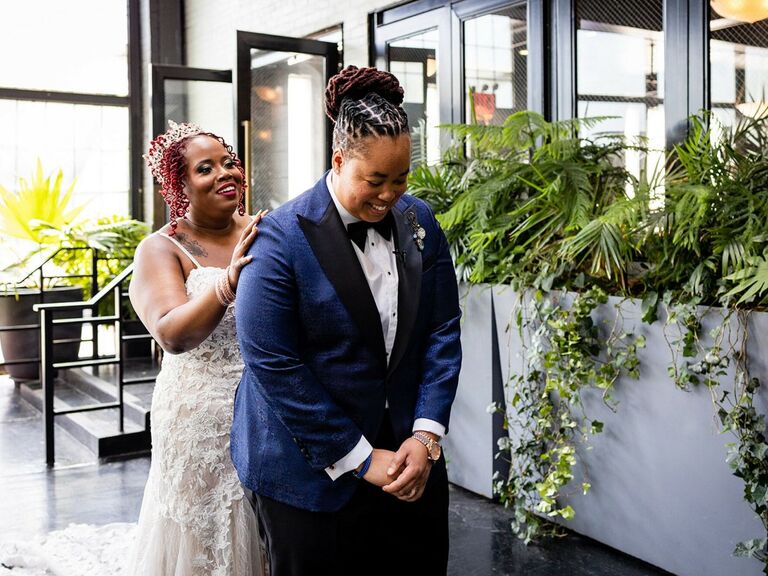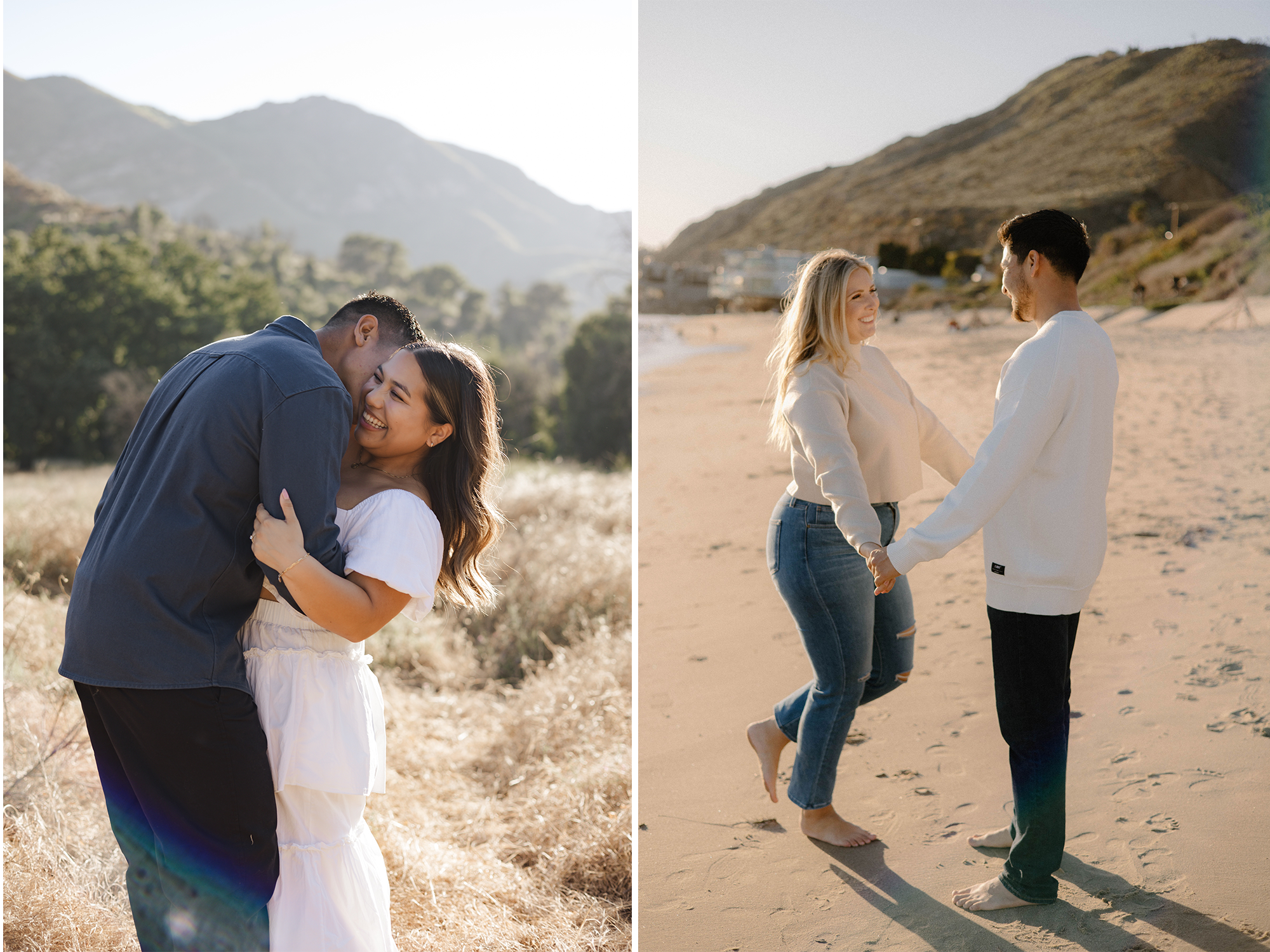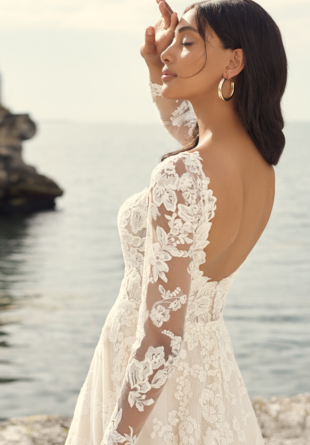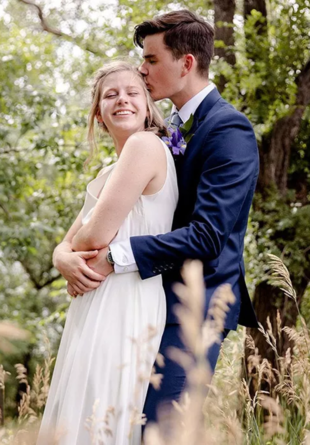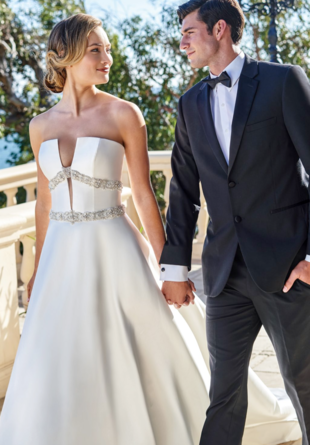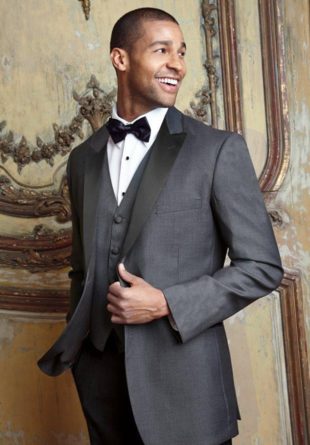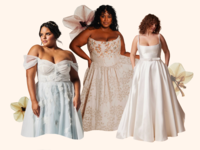How Should a Suit Fit? A Wedding Suit Fit Guide
How is a suit supposed to fit? It's a good question. The most expensive suit (or tux) in the world is going to look cheap if the fit is off, and a budget buy can look like a million bucks with the right alterations. There's no one-size-fits-all (apologies for the pun) answer, either. The way a suit should fit is determined by its cut, the occasion, the fabric, and everything in between. Don't panic, though–it's not time to torch your closet just yet. If you're wondering where your jacket sleeves should fall or how snug the chest should fit, where your trouser hems should fall or how high the rise of their waist should be, you've come to the right place. Here's everything you need to know about how a suit should fit.
In this article:
- How Should a Suit Fit?
- Top Suit Fit Mistakes to Avoid
- Suit Jacket Fit
- Suit Pants Fit
- How Should a Suit Fit by Suit Type
How Should a Suit Fit?
In short? Not too snug, not too loose. The perfect suit fit is going to fit to your form without hugging it too tight and have plenty of room for you to fit a couple of other layers under the jacket. Traditionally this means a shirt and maybe a vest, but suits can also be paired with turtlenecks and sweaters. It's why suits are such an essential wardrobe piece: they're versatile. When they fit right it doesn't matter if you're wearing a nice tee shirt underneath, a thick sweater, or a shirt and tie. It'll always look good.
Top Suit Fit Mistakes to Avoid
The most common issue I see with suit fit is the length of the jacket's sleeves. There's a presumption that a suit sleeve should hit below your wrist. In fact, a suit sleeve should break just above your wrist, allowing the shirt sleeve and your watch (if you're wearing one) to be shown off.
-
After the last decade of menswear encouraged a slim fit, the problem is now suits that fit too slim. We went too far! Give it some room to breathe and don't treat the fit of your suit pants like a pair of skinny jeans.
FEATURED VIDEO FROM THE KNOT Whether you're aiming for a slimmer fit or a relaxed one, make sure your suit's proportions match. This means thicker lapels for suits with a more relaxed fit and narrower ones for suits with a slimmer fit.
Suit Jacket Fit
Your suit jacket is going to be the first thing people notice–which means it's going to be the first thing they clock the fit of as well. Make sure everything is just right to leave a first impression that lasts.
Lapels
Standard suit lapels should be between 3 and 3.5 inches wide. It's okay to skew slimmer or wider, but doing so has to be a deliberate styling choice and the rest of your suit's proportions should follow accordingly. What you really need to look out for with the proportions of your lapel is what you pair the suit with. Your dress shirt's collar and the tie (if you're wearing one) should be proportionate to the size of your lapels. This means smaller collars and skinner ties for slimmer lapels and bigger collars with thicker ties for wider lapels.
Shoulders
Your suit should cradle your shoulders, not strangle them or drown them in fabric. If you feel that you can't comfortably move your arms and shoulders they're likely too tight. On the other hand, excess fabric in your jacket's shoulders indicates that they're too big. The thick shoulder look is great if you're going for '80s Wall Street shoulder pads but not if they're just overlong and boxy. Ideally the point where your suit's sleeve meets the shoulder should fall right around the edge of your own shoulder, hanging off no more than about a quarter of an inch.
It's important to note the fact that while a lot of bad fit issues can be solved by a tailor, the shoulders are the hardest part of a jacket to alter. As such, this is definitely the part of the jacket you want to be sure fits as well as possible when making your purchase.
Chest & Torso
When a suit jacket fits well, it fits just ever-so-slightly loose. A great gauge for this is seeing if you can comfortably fit two fingers between your shirt and the jacket when the suit is buttoned up. You should be able to do this with relative ease, though not so much ease that there's zero resistance. If that's the case, you may need to have the suit brought in a little bit as it's likely too baggy.
You should also take notice of where the jacket's armpits hit. They don't need to meet the natural point of your armpits but they shouldn't hang too much lower. If they do, you'll find that moving your arms around is difficult as they'll take the rest of the suit with them when they do.
Button Closure
You should be able to button your suit comfortably, not too loose and not too snug. If you can fit more than two fingers between your jacket's button closure and shirt it's probably a bit too loose. On the other hand, if you're noticing stretching and creases in the fabric of the jacket when the suit is buttoned, it's too tight.
Sleeves
Sleeve length is one of the most common suiting mistakes these days. It's not so much that everyone wearing a suit is walking around with comically long sleeves so much as that suit sleeves are actually supposed to fit just a little bit shorter than you likely realize. Common instinct is lthat your suit sleeve should break evenly at your wrist, which is understandable - after all, it's roughly where shirt sleeves are supposed to hit.
But suit sleeves are actually supposed to fit just a hair shorter than that. A suit sleeve should break a quarter to a half an inch above your wrist. The intention here is to let a bit of your shirt sleeve be visible from underneath the suit. It also allows for cuff links (if worn) and watches to get a bit of spotlight. That being said, your shirt sleeves definitely shouldn't break more than about half an inch above your wrist.
Length
Common wisdom on how long your suit should be has way more to do with proportion than hard rules and measurements. Generally it's going to depend on the length of your torso in relation to the rest of your frame. A reliable test you can try to figure out how your suit fits is the hand test. Let your arms hang naturally by your sides. Without reaching up or down, curl your fingers into the palm of your hand. If your suit is the right length, you should be holding onto it. If it's too short or too long, you'll miss the hem and won't be holding anything.
On the back side, the hem of your suit should be just long enough to cover the curve of your backside.
Suit Pants Fit
The fit of a suit pant is much simpler than that of a jacket. After all, we've all worn a pair of pants before, right? Read on for more on how to make sure your suit pants fit.
Waist
If your suit pants are sitting at the relatively standard rise of your waist, you should stick with your traditional waist measurement. You may find yourself needing to alter the size for a higher or lower rise but if you're opting for a traditional fit, this one is an easy-enough call. You should be able to let the pants rest at your waist without the significant help of a belt. Having to buckle a belt too tight is going to cause fabric to bunch and won't have your suit looking its best.
Seat
The fit of your suit's seat (and yes, that means the butt) is actually going to be determined by a number of other factors, including the waist, rise, thigh measurement, and crotch. In short, if you feel like you can't sit down without tearing your pants, the seat is too tight. The ideal seat fit conforms to the curvature of your backside without being too tight to move around. You don't want it too baggy or too droopy in the crotch, both indicators of pants that are too big.
Rise
A standard suit pants' rise (for those wondering, this means how far up your torso the waistband hits) will have the waistband falling just below your belly button. Trousers with an intentional higher rise (which are very much in style right now) will hit at or above the belly button but will have extra length in the inseam and in the crotch to compensate for this.
Pockets
This one is pretty simple. Like the fit of the seat, the fit of your pants pockets are largely indicated by the other measurements in the garment. In short, you should be able to fit your phone, wallet, keys, and any other standard everyday carry items in your suit pants' pockets comfortably. If you can't, they're likely a bit too small.
Inseam
Your pants' inseam should break right around the point where your ankle meets your foot. There's some room for flexibility here if you're going for an intentional ankle-bearing look (in which case take it up about an inch) or if you're looking to cuff your trouser legs (in which case consider consulting a tailor). Otherwise, it's as simple as trying the pants on with the shoes you intend to wear with them and making sure the break is clean at the shoe.
How Should a Suit Fit by Suit Type
Broadly, most suits should adhere to the above guidelines regardless of the cut or the fit. However, some styles require (or in some unique cases don't require) a bit of an adjustment. Whether you're rolling up to your next wedding in a classic standard suit or a slick double-breasted number, here's everything you need to know about how different suit styles should fit.
Slim Fit Suit Fit
How should a slim suit fit? This one is a bit of a trick question. A slim fit suit is way more about proportion than it is fit. A suit with narrower lapels and a slimmer, more tapered pant leg should still have all of the fit of a standard suit. This is to say that the above guidelines should still be observed–the pants should break at the point where your ankle and feet meet, you should still be able to fit two fingers between your shirt and jacket when the jacket is buttoned, and your sleeves should still break just a hair above your wrist.
Double-Breasted Suit Fit
Despite the less-conventional button closure, double-breasted suits fit roughly the same as standard ones. The one exception is that double-breasted jackets tend to fit slightly looser when unbuttoned. This is a feature, not a bug–a double-breasted jacket has more fabric to compensate for the closure, so when unbuttoned it should have a bit more flow than a single-breasted suit.
Wide/Unstructured Suit Fit
Wide-cut and unstructured suits allow you to bend a few suiting fit rules without necessarily breaking them. By nature they're supposed to feel a little more casual, a little more loose, and a little less structured. With wide and unstructured fits you can get away with slightly looser shoulders and a bit extra length in the inseam of your pants. The two-finger rule when the jacket is buttoned can be more of a three-finger rule.
However, what you're often going for with a wider or unstructured suit is not so much a suit that isn't fitted properly as it is one that looks like it isn't totally fitted properly. With unstructured suits the lack of canvasing in the jacket (material between the outside fabric and the inner lining that provides shape and conforms to your body over time) does most of the work in providing the suit with a more laid-back vibe.
Tuxedo
This one is pretty simple: all of the guidelines above apply to tuxedos as well.
